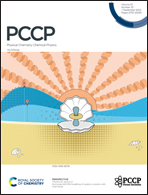Sequential flipping: the donor–acceptor exchange mechanism in water trimers†
Abstract
The donor–acceptor exchange (DAE) is a significant hydrogen bond network rearrangement (HBNR) mechanism because it can lead to the change of the hydrogen bond direction. In this work, we report a new DAE mechanism found in water trimers that is realized by sequential flipping (SF) of all molecules rather than the well-known proton transfer (PT) process. Meanwhile, the SF process has a much smaller potential barrier (0.262 eV) than the previously predicted collective rotation process (about 1.7 eV), implying that the SF process is the main flipping process that can lead to DAE. Importantly, high-precision ab initio calculations show that SF-DAE can make the water ring to show a clear chiral difference from PT-DAE, which brings the prospect of distinguishing the two confusing processes based on circular dichroism spectra. The reaction rate analysis including quantum tunneling indicates an obvious temperature-dependent competitive relationship between the SF and PT processes; specifically, the SF process dominates above 65 K, while the PT process dominates below 65 K. Therefore, in most cases, the contribution for DAE mainly comes from the flipping process, rather than the PT process as previously thought. Our work enriches the understanding of the DAE mechanism in water trimers and provides a piece of the jigsaw that has been sought for the HBNR mechanism.



 Please wait while we load your content...
Please wait while we load your content...